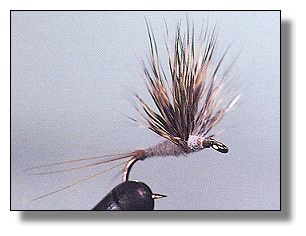
 March Brown Comparadun By Skip Morris
|
|
|
|
Tying Instructions:
1. Build a layer of thread; comb, stack, measure; then tie in a bunch
of deer hair.
 2. Push the wing down around the hook and add a few more tight thread turns.

|
|
3. Snip the hair butts at an angle, bind them with thread and build a thread
ball at the bend. (This will be used to seperated the tails later.)
 4. Tie in some hackle fibers and wrap back over them with thread; nearing the thread ball, pull the fibers down around it and add the final turns of thread.
 5. Dub to the wing, and then crease the wing upright, once on top and once on each side.
|
 6. Draw the wing sharply back and take a turn of dubbing up against the front of its base.
 7. Crisscross the dubbing beneath the wing. Add more dubbing in front of the wing and complete the head as usual.
 8. Snip the center fibers from the tail, leaving split tails.
 9. Split tails.
Tying Tips for the March Brown
2. The distribution of hairs in the wing is a good indication of how the wing was tied in - if the hairs are clumped at the center, you need to push the wing down around the hook more as you secure it with thread turns. 3. An ever more secure way to set the wing upright is to use lots of tight turns of bare thread against the front of the wing; then dub around and beneath the wing to the head area. 4. Another way to snip the tail fibers is to leave the fly in the vise, and then pull some outside fibers toward you to separate them from the rest for clear access with your scissor tips.
|
Fishing Suggestons
We thank
Frank Amato Publications Inc. for use permission for this excerpt from
Fly Tying Made Clear and Simple, By Skip Morris.
|
[ HOME ]
[ Search ] [ Contact FAOL ] [ Media Kit ]